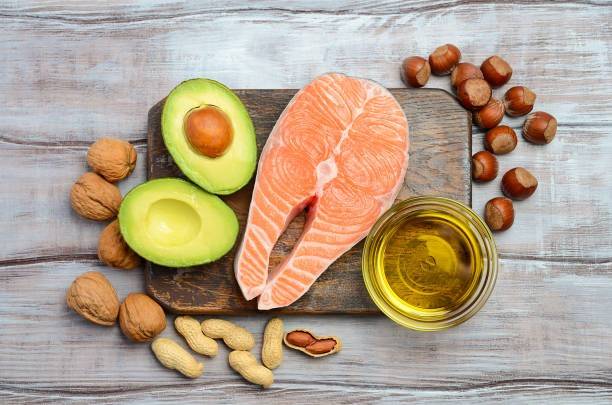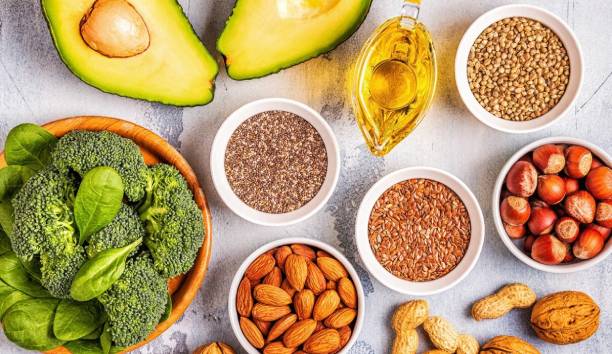The distinction between saturated and polyunsaturated fats
Fats are essential nutrients for the human body. Saturated fats, they differ The most significant food sources are beneficial, while others are dangerous and can induce a variety of ailments. Continue reading to learn about the distinctions between saturated and unsaturated fats, as well as the most significant dietary sources for each. Learn more from your expert medical team.
Fats are essential nutrients for the body since they provide energy for metabolic, muscular, digestive, and cerebral activities. They are also required for the absorption of some minerals, including vitamin D. They are also an important component of cell membranes and are required for cell division and reproduction. They also form the majority of the brain and neurological system. Dietary fats consist mostly of cholesterol, triglycerides, and saturated and unsaturated fatty acids.
Saturated fats are those that are made up entirely of fatty acids with single bonds rather than double bonds.
Fatty acids are composed of chains of carbon and hydrogen atoms, with each carbon atom bonded to two other carbon atoms via a form of chemical interaction known as covalent bonds. A single carbon atom may establish four covalent connections, each with a previous carbon atom, a following carbon atom, and two hydrogen atoms.
Covalent bonds can be single or double. A chain is saturated (four covalent bonds) if the bond is single and unsaturated (fewer than four covalent bonds) if the bond is double.

saturated fats
Saturated fat is known in English as saturated fat.
What are unsaturated fats?
Unsaturated fats are those in which the fatty acids have double or double bonds. In this situation, the double bond lowers the number of atoms with which the carbon atom may bind; hence, they are considered unsaturated.
unsaturated fats
Unsaturated fat is known as unsaturated fat in English, with unsaturated fats being the forms of unsaturated fats, which are polyunsaturated fats and monounsaturated fats.
monounsaturated fats
Monounsaturated fats are those whose fatty acids are polyunsaturated fats, thus the names monounsaturates or monounsaturated.
polyunsaturated fats
Polyunsaturated fats include fatty acids with more than one double bond. These fats can have two double bonds, which is why they are also known as diunsaturated fats.

What's the difference between saturated and unsaturated fats?
Saturated fats are solid at room temperature and can be found in cattle and goat meat, butter, and margarine.
Saturated fats take longer to break down and metabolize in the body because the single bonds between the carbon atoms that make them up are strong and demand a lot of energy to break down.
Learn about the best strategies to lose belly and waist fat.
These fats are utilized to form cell membranes or are stored in adipose tissue. Consuming significant amounts of them may increase the risk of heart and artery disease, as well as increase blood levels of dangerous LDL cholesterol.
Unsaturated fats are predominantly liquid at normal temperature. Olive oil and sunflower oil are examples of these fats. Unsaturated fatty acids' double bonds are weak and easily broken or modified in their chain structure. As a result, unsaturated fats are easier to absorb and digest than saturated fats. Because of their liquid nature, these lipids are neither stored nor utilized in cell formation. However, they are high in energy and contain critical components that aid in metabolism, physiological function, absorption, and memory. Omega-3 fatty acids are the most prevalent unsaturated fat-derived molecules.
The primary dietary sources of saturated and unsaturated fats
Fats of all sorts are abundant in dietary sources, and the majority of foods include some saturated fat, unsaturated fat, or both. The following foods are the best suppliers of each category of dietary fat.
Type of Fat | The most important food sources |
saturated fats | Animal meats and fats include cattle, goat, and chicken, as well as whole milk and dairy products such as butter, ghee, cheese, coconut, and palm oil. |
monounsaturated fats | Oily fish, including salmon, mackerel, tuna, sardines, and herring; ground flax and flaxseed oil; soybeans; oysters; sunflower, chia, and hemp seeds; soybean, sunflower, walnut, and maize oils. |
polyunsaturated fats | Olive oil, peanut oil, avocado, pistachios, cashews, almonds, and hazelnuts, as well as pumpkin and sesame seeds. |
Your medical treatment advice is to achieve a balanced diet.
A balanced diet should contain all of the nutrients required for the body's health and safety. You should also avoid ingesting any vitamin in excess, since both circumstances may be harmful to the body. To maintain a healthy, balanced diet, consider the following tips:
Consume enough protein, which may be derived from beef, goat, chicken, eggs, milk, and other foods.
Consume reasonable amounts of natural saturated fats such as butter, ghee, milk, beef, and fowl. Avoid processed saturated fats like margarine and hydrogenated meals like fried foods since they are unhealthy and have no nutritional benefit.
Consume foods high in unsaturated fatty acids in suitable quantities. Adequate consumption of these fats is good for your health and improves metabolism and focus, but don't overdo it, as it might have negative side effects. Oily fish and nuts are excellent suppliers of these fats.
Avoid drinking excessive quantities of sugar. In a healthy diet, added and processed sugars should be avoided since they are toxic, causing weight gain and reduced immunity. Sugars may be gotten in a healthy manner from fruits such as apples, oranges, strawberries, and summer fruits such as melons, peaches, and so on.
Consume meals high in vitamins and minerals, as these are essential for the majority of the body's fundamental processes. Eat green vegetables like lettuce, parsley, and spinach, as well as carrots, tomatoes, and other peppers.

Benefits of Dietary Fats
Fats in the diet are essential for preserving the body's health and safety, as well as assuring the continuity of all crucial metabolic activities. Fats have a role in the formation of new cell membranes, cell division, and reproduction, as well as the absorption of vitamins from the gut by producing bile acids and depending on the fat-soluble properties of particular vitamins, including vitamin D. Fats are also a great source of energy, providing the energy needed for the proper function of all tissues and organs in the body. Fats create important metabolic molecules that control a variety of biological activities. Omega-3, omega-6, and other fatty acids assist in controlling focus and memory processes while also improving brain health. Several bodily hormones, including cortisol and sex hormones, are also created from cholesterol.
Consume reasonable quantities of natural saturated fats to support healthy cell membranes, regular cell reproduction, and enough fat storage in the body. These fats are present in animal foods and poultry, including chicken, milk, butter, ghee, and other goods.
It is also necessary to consume foods high in unsaturated fats, such as fish, nuts, and olive oil, in order to receive enough levels of omega-3 and omega-6 components.
Avoid hydrogenated, processed, or artificial fats. These fats are particularly damaging to the body, contributing to obesity and weight gain while also raising blood lipid levels, increasing the risk of heart disease and atherosclerosis. They also have no nutritional value, and the body is unable to break down and use them. These fats are present in margarine, fried meals like French fries, and fast food.
What are the recommended levels of fat consumption?
Fats should account for 20-35% of an adult's total daily calorie consumption. If you eat around 2,000 calories per day, you should consume between 44 and 77 grams of fat. This quantity should be spread to include all types of good fats required by the body, such as:
Monounsaturated fat content: 15%–20%
Polyunsaturated fat content: 5-10%
Saturated fat content < 10%
Cholesterol below 300 mg every day.
Frequently asked concerns regarding saturated and unsaturated fats
Saturated fats get their name from the fact that the carbon atoms in them are bound to as many hydrogen atoms as possible, implying that they are hydrogen-saturated.
Saturated fats may be found in meat and fat from animals including cow, goat, and chicken, as well as whole milk, dairy products, butter, and cheese.
Breast milk contains around 4.9 grams of saturated fat per cup (246 ml) and 6 grams of unsaturated fat.
When ingested in moderation, saturated fats lower bad cholesterol in the blood, raise good cholesterol, and minimize the risk of heart and vascular disease. They also contribute to the formation of cell membranes, as well as the maintenance and reproduction of cells.
Excess saturated fat consumption can contribute to obesity and weight gain since these fats are stored and unutilized. In this instance, blood fat levels may rise, resulting in heart and vascular disease and an increased risk of stroke.
Unsaturated fats are not stored in the body, but rather used for metabolism and energy generation. As a result, they do not increase body weight. Sedentary, inactive, or excessive consumption of unsaturated fats might lead to weight gain.
When taken in excess, saturated fats promote cardiovascular disease by raising the quantity of bad cholesterol in the blood, which can build on the artery walls and lead to heart disease and high blood pressure.
Double bonds reduce the amount of hydrogen atoms that each carbon atom may bind with. In this situation, the carbon atom is not saturated with hydrogen, because the amount of hydrogen atoms falls as the number of double bonds rises.
Oily fish including tuna, mackerel, salmon, and sardines contain unsaturated fats, as do other oils, nuts, seeds, and cereals.
The body breaks down unsaturated fats into smaller molecules, which it then transforms into energy-producing chemicals like ATP. These lipids can also be converted to sugars during fasting or hypoglycemia.
Unsaturated fats give the body with a substantial quantity of energy, which it need to function and maintain numerous metabolic processes. They also increase children's memory, focus, and development while lowering the risk of heart disease.
Trans fats are safe when ingested in moderation, however excessive intake may raise the risk of stroke.
Both types of fats are essential for good health, however unsaturated fats are easier to digest, less toxic, and more useful than saturated fats.

